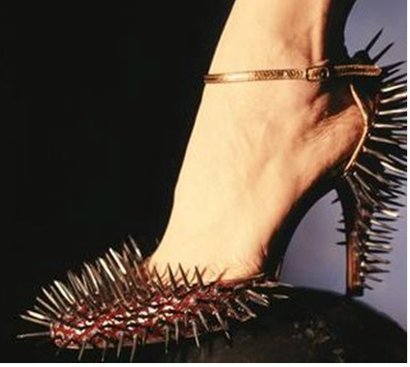It's true that nothing can lift the spirits like a sassy new pair of high heels. But if it seems those heels were a lot more comfortable in your 20s and 30s then they are in your 40s, 50s, and beyond, you're right. Feet change with age, say experts, and some of those changes can make wearing high heels a lot less comfortable. One of the most common: a loss of fat in the bottom of the foot. As you age, you lose some of the fatty deposits that normally protect the ball of the foot -- and some of it also slides forward towards the toes.
 Anytime you wear shoes that are tight or constrict the natural shape of your foot, doctors say it's bound to cause foot pain. But when you add high heels in to the equation, pain can quickly escalate to damage. In addition to restricting the foot, you are also increasing the weight on the area that is restricted, so you're not only crushing your toes, but you're crushing them and then putting weight on them, and that's a problem Among the most common problems he sees are painful, aching bunions -- those bony protrusions that usually pop up at the base of the big toe and distort the shape of the foot.
Anytime you wear shoes that are tight or constrict the natural shape of your foot, doctors say it's bound to cause foot pain. But when you add high heels in to the equation, pain can quickly escalate to damage. In addition to restricting the foot, you are also increasing the weight on the area that is restricted, so you're not only crushing your toes, but you're crushing them and then putting weight on them, and that's a problem Among the most common problems he sees are painful, aching bunions -- those bony protrusions that usually pop up at the base of the big toe and distort the shape of the foot.
High heels don't cause bunions, but they sure can aggravate them. Both the heel height and the point of the shoe can play a role. Some women who have bunions also have a displaced bone on the bottom of the big toe joint, which changes the way the foot "tracks" or acts during motion. If the foot is then placed in a high heel, and pitched forward, the pressure on these bones increases and bunion pain grows worse. While integrating lower heels into your wardrobe can help some, often the best solution is bunion surgery to straighten the bone.
If you're wearing high heels on a daily basis, it's likely you've already experienced two more common problems: corns and calluses. These thickened layers of dead skin usually occur on the toes or sides of the foot and are actually the body's way of defending your feet against assault. Only in this case your shoes are the enemy. When you start developing corns and callus, or even ingrown toe nails, pressure from shoes that don't quite fit is often the problem. Other times it can be the result of a "hammertoe" -- a condition that causes the bone of the affected toe to curl under, leaving the top to rub against the shoe. When that shoe is a high heel, problems and pain are intensified. While wearing a lower heel shoe can help some, the solution may require a surgical procedure that helps straighten the hammertoe. Call your podiatrist if you have any problems or concerns. Because when your feet hurt, you hurt all over!!


Women loves wearing high heels especially those that are not tall. This gives them confidence and self esteem.
ReplyDeleteMuch thanks for composing such an intriguing article on this point. This has truly made me think and I plan to peruse more neuropathy
ReplyDelete